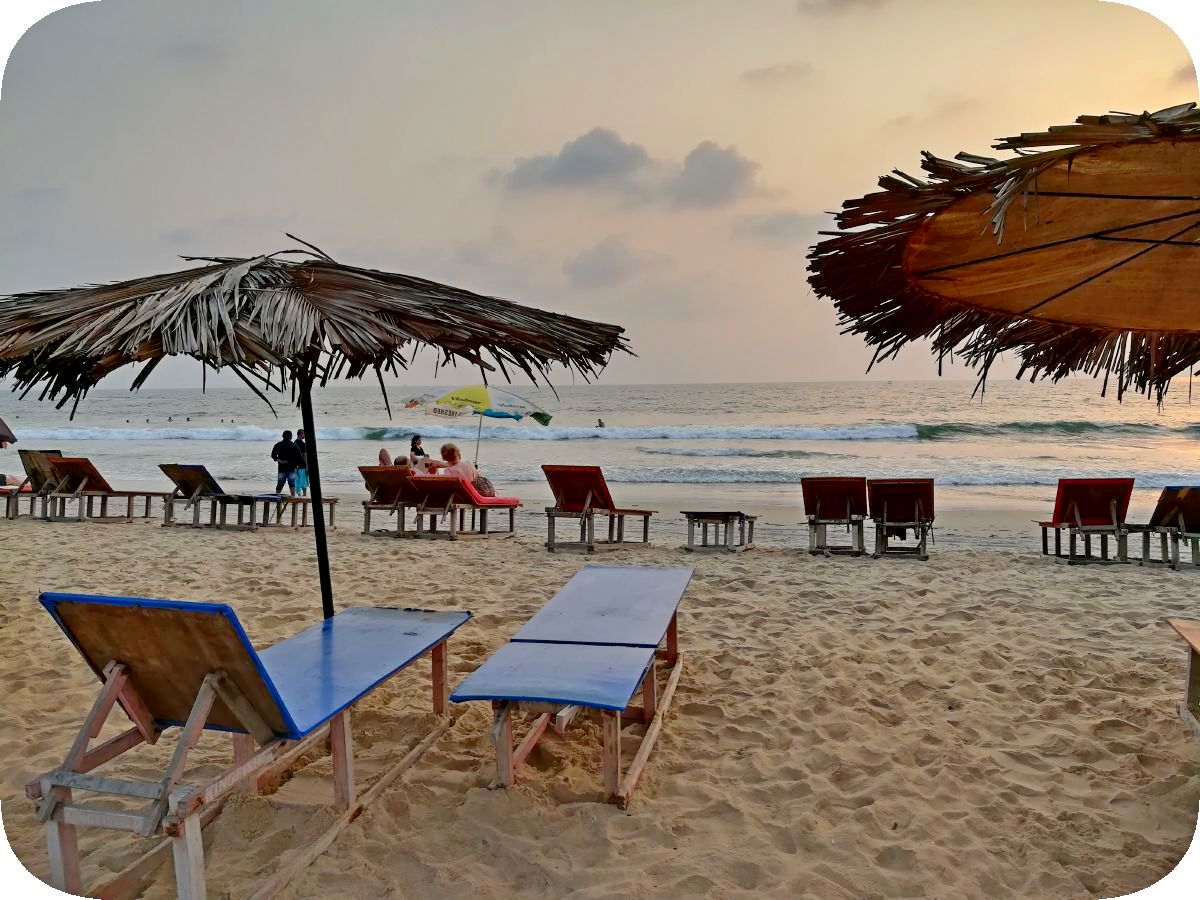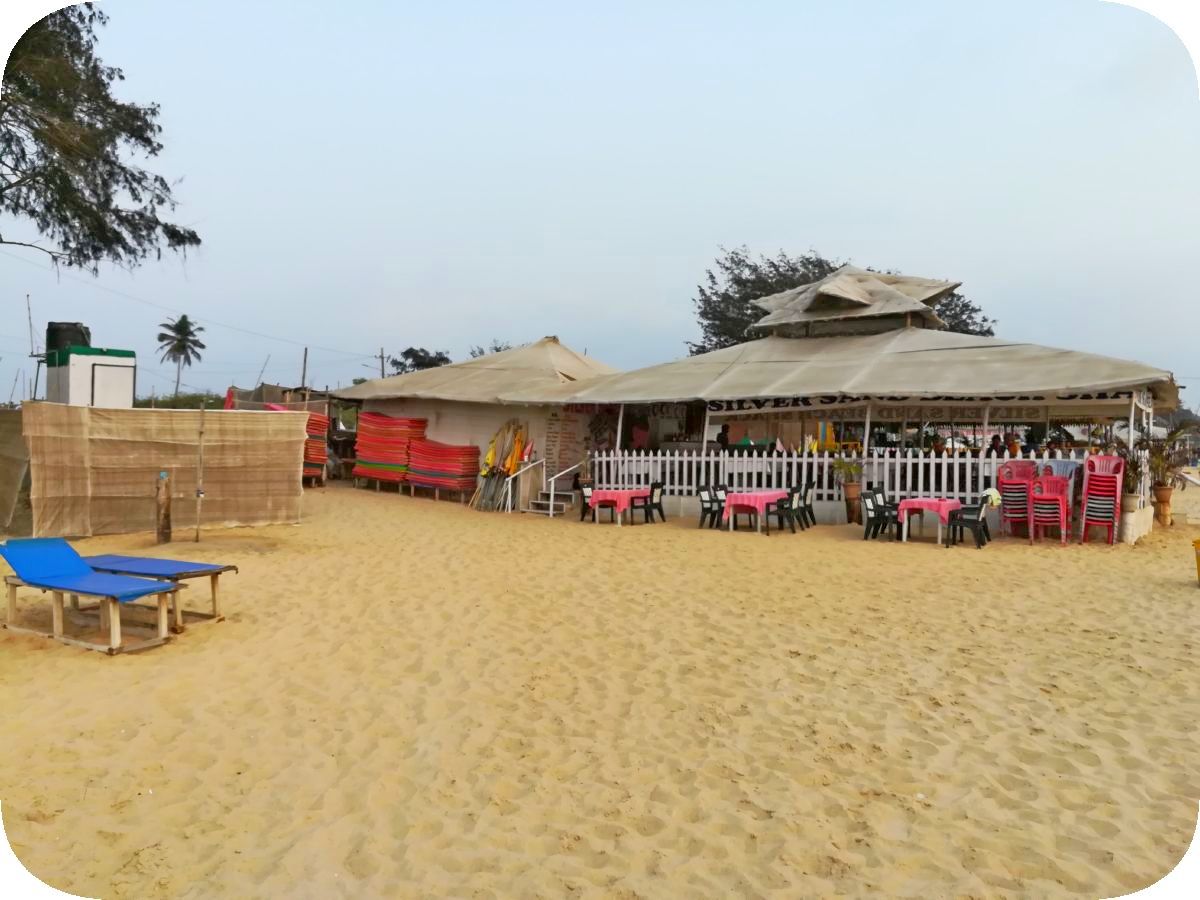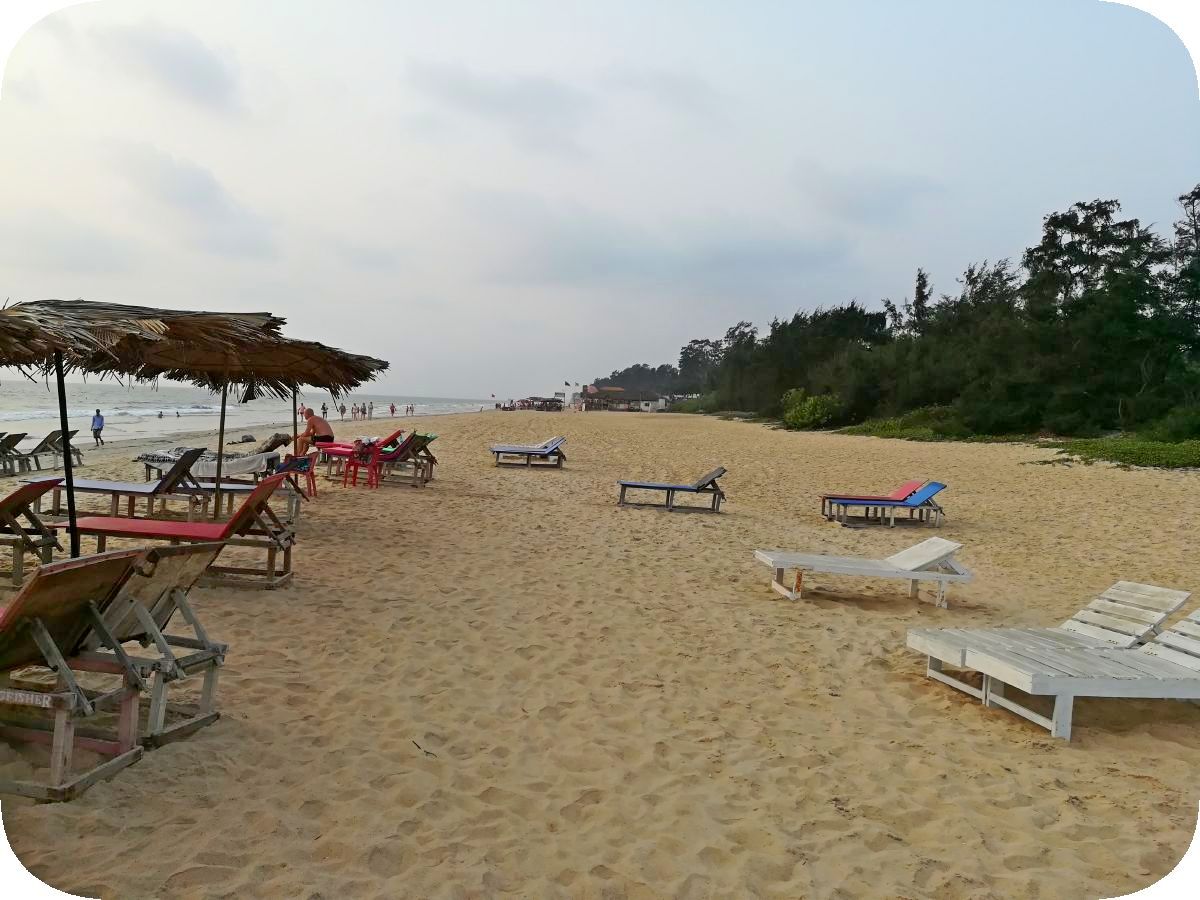HALLO.HIVE!

We continue walking along the Cavelossim beach in South Goa, in its second part, after the wasteland. Let me remind you that Goa is not an island, but a small state in India, located on the shores of the Arabian Sea. The sea is not the cleanest and most transparent, the red sand makes the water pretty muddy, but there are places like Agonda and Palolem with clear water and even without waves. Usually these are secluded bays, so look at the Google map before the trip and you will be happy.
By the way, here in the photo is a typical beach cafe-shack. A temporary prefabricated structure made of wood, plywood and roof covering. Once the beach season is over, all this stuff will be dismantled. Because when the rains start and storms come, all this will quickly rot, and building a disposable cafe is too expensive. Then, before the new season, there will be an auction to allocate a place for a cafe with a certain number of seats and loungers. A strictly defined number of loungers is allowed. And although in India everything is ruled by "baksheesh", sometimes there are police raids on the beach and almost always "extra loungers" are found, the cafe is closed for a day or two, and then "baksheesh" solves the problems and the cafe works again. And the auctions here are something else, the same cafes have been standing in permanent places on the beach for decades. The East is a delicate matter!

To the left of the cafe you can see a white toilet building with a black plastic barrel for water on top. Regular cold water is supplied here, it heats up perfectly in the sun, a good saving on heating the water. Shower, toilet and changing room in one bottle. Extremely necessary and useful amenities of beach life, especially if you come here for the whole day. The mattresses are made mainly of waterproof leatherette, but in some places you can find trash like piss-stained striped mattresses. The sun loungers are mostly wooden. Ugly, clumsy, but repairable and exotic. Plastic quickly fades in the hot sun, becomes brittle and breaks. Who said that this is a cafe from the first part of the beach? You can't fool me, you have such sharp eyes!
Over time, you get used to wooden sun loungers. They are not so bad, but only if there is a soft mat on top. And don't be surprised if a beach dog comes to visit you and lies down in the shade under the sun lounger. In Goa, this is normal, usually during the day the dogs here are quiet and friendly. And they are ready to eat even cookies if you treat them, because life is not sugar.

The sand here is not as red as on many beaches in Goa, it is closer to golden-white. But, IMHO, the sand on Varka and Zalor is more interesting, it is finer and whiter, almost like starch, it crunches amusingly underfoot. But it sticks to the wet body like crazy - you will have to wash it off for a long time if you suddenly decide to lie on the sand. Cavelossim beach is more lively, there are more people here, after all, by Goa standards it is a large village. The music plays louder here, on Zalor it is much quieter, that's why we chose it. If you want complete silence - choose Agonda, you can't make noise there, because there is a turtle nursery. But sometimes there is a problem when all the sun loungers are removed from the beach, because of the same turtles (the sun loungers are placed closer to the cafe). For us, Goa is first and foremost not a noisy party, but a quiet relaxation with contemplation of the sea. But everyone relaxes the way they want, if it is not illegal, ha. The beach seal day is already over, many vacationers have left, but some are still on the shore.

● ..to be continued...
Wir wandern weiter am Cavelossim Beach in Süd-Goa entlang, in seinem zweiten Teil, nach dem Brachland. Zur Erinnerung: Goa ist keine Insel, sondern ein kleiner Staat in Indien am Arabischen Meer. Das Meer ist nicht besonders sauber und durchsichtig, der rote Sand macht das Wasser ziemlich schlammig, aber es gibt Orte wie Agonda und Palolem mit klarem Wasser und sogar ohne Wellen. Meist handelt es sich dabei um abgelegene Buchten. Werfen Sie also vor der Reise einen Blick auf Google Maps, und Sie werden begeistert sein.
Hier auf dem Foto ist übrigens eine typische Strandcafé-Hütte zu sehen. Eine provisorische Fertigkonstruktion aus Holz, Sperrholz und Dach. Nach der Strandsaison wird all das abgebaut. Denn wenn Regen und Stürme einsetzen, verrottet alles schnell, und der Bau eines Einwegcafés ist zu teuer. Vor der neuen Saison wird dann eine Auktion stattfinden, um einen Platz für ein Café mit einer bestimmten Anzahl von Sitzplätzen und Liegen zu vergeben. Es ist eine streng festgelegte Anzahl an Liegen erlaubt. Und obwohl in Indien alles nach dem „Bakschisch“-Prinzip geregelt ist, gibt es manchmal Polizeirazzien am Strand, und fast immer werden „zusätzliche Liegen“ gefunden. Das Café ist für ein oder zwei Tage geschlossen, und dann löst das „Bakschisch“ die Probleme, und das Café öffnet wieder. Und die Auktionen hier sind etwas ganz Besonderes: Die gleichen Cafés stehen seit Jahrzehnten an festen Plätzen am Strand. Der Osten ist eine heikle Angelegenheit!
Links vom Café sieht man ein weißes Toilettengebäude mit einem schwarzen Plastikfass für Wasser. Hier gibt es normales kaltes Wasser, das sich in der Sonne perfekt erwärmt – eine gute Ersparnis beim Erhitzen des Wassers. Dusche, Toilette und Umkleidekabine in einer Flasche. Äußerst notwendige und nützliche Annehmlichkeiten des Strandlebens, besonders wenn man den ganzen Tag hier verbringt. Die Matratzen bestehen hauptsächlich aus wasserdichtem Kunstleder, aber an manchen Stellen findet man Müll wie pissbefleckte, gestreifte Matratzen. Die Sonnenliegen sind meist aus Holz. Hässlich, unhandlich, aber reparierbar und exotisch. Plastik verblasst in der heißen Sonne schnell, wird spröde und bricht. Wer hat gesagt, dass das hier am ersten Strandabschnitt ein Café ist? Du kannst mich nicht täuschen, du hast so scharfe Augen!
Mit der Zeit gewöhnt man sich an Holzliegen. Sie sind gar nicht so schlecht, aber nur, wenn eine weiche Matte darauf liegt. Und wundert euch nicht, wenn euch ein Strandhund besucht und sich im Schatten unter der Liege niederlässt. In Goa ist das normal, tagsüber sind die Hunde hier normalerweise ruhig und freundlich. Und sie fressen sogar Kekse, wenn man sie verwöhnt, denn das Leben ist nicht zuckersüß.
Der Sand hier ist nicht so rot wie an vielen Stränden in Goa, er ist eher goldweiß. Aber meiner Meinung nach ist der Sand auf Varka und Zalor interessanter, er ist feiner und weißer, fast wie Stärke, er knirscht lustig unter den Füßen. Aber er klebt wahnsinnig am nassen Körper – man muss ihn lange abwaschen, wenn man sich plötzlich dazu entschließt, sich in den Sand zu legen. Der Strand von Cavelossim ist belebter, hier sind mehr Leute, schließlich ist es für Goa-Verhältnisse ein großes Dorf. Die Musik spielt hier lauter, auf Zalor ist es viel ruhiger, deshalb haben wir uns für diesen Ort entschieden. Wenn Sie absolute Ruhe wünschen, wählen Sie Agonda, dort können Sie keinen Lärm machen, denn dort gibt es eine Schildkrötenaufzuchtstation. Manchmal gibt es jedoch ein Problem, wenn alle Liegestühle wegen derselben Schildkröten vom Strand entfernt werden (die Liegestühle stehen näher am Café). Für uns ist Goa in erster Linie keine laute Party, sondern ruhige Entspannung mit Blick aufs Meer. Aber jeder entspannt, wie er will, sofern es nicht verboten ist, haha. Der Tag der Strandrobben ist schon vorbei, viele Urlauber sind abgereist, aber einige sind noch am Ufer.
● ...Fortsetzung folgt...
